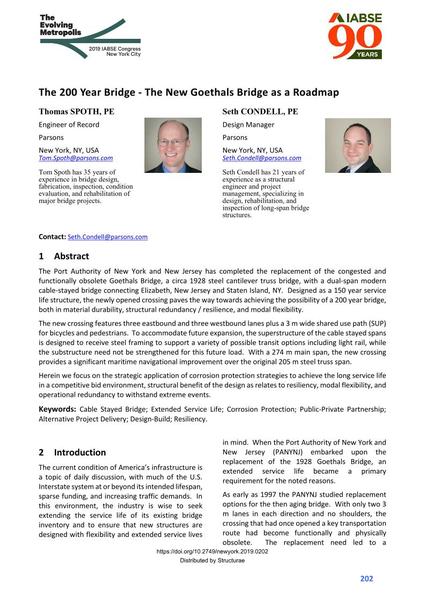The 200 Year Bridge - The New Goethals Bridge as a Roadmap

|
|
|||||||||||
Détails bibliographiques
| Auteur(s): |
Thomas Spoth
(Parson)
Seth Condell (Parson) |
||||
|---|---|---|---|---|---|
| Médium: | papier de conférence | ||||
| Langue(s): | anglais | ||||
| Conférence: | IABSE Congress: The Evolving Metropolis, New York, NY, USA, 4-6 September 2019 | ||||
| Publié dans: | The Evolving Metropolis | ||||
|
|||||
| Page(s): | 202-209 | ||||
| Nombre total de pages (du PDF): | 8 | ||||
| DOI: | 10.2749/newyork.2019.0202 | ||||
| Abstrait: |
The Port Authority of New York and New Jersey has completed the replacement of the congested and functionally obsolete Goethals Bridge, a circa 1928 steel cantilever truss bridge, with a dual-span modern cable-stayed bridge connecting Elizabeth, New Jersey and Staten Island, NY. Designed as a 150 year service life structure, the newly opened crossing paves the way towards achieving the possibility of a 200 year bridge, both in material durability, structural redundancy / resilience, and modal flexibility. The new crossing features three eastbound and three westbound lanes plus a 3 m wide shared use path (SUP) for bicycles and pedestrians. To accommodate future expansion, the superstructure of the cable stayed spans is designed to receive steel framing to support a variety of possible transit options including light rail, while the substructure need not be strengthened for this future load. With a 274 m main span, the new crossing provides a significant maritime navigational improvement over the original 205 m steel truss span. Herein we focus on the strategic application of corrosion protection strategies to achieve the long service life in a competitive bid environment, structural benefit of the design as relates to resiliency, modal flexibility, and operational redundancy to withstand extreme events. |
||||
| Mots-clé: |
Pont à haubans
|
||||
